单例模式,反射破环?
饿汉式
// 饿汉式单例public class Hungry { //构造器私有 private Hungry(){ } // 一上来就把这个类加载了 private final static Hungry HUNGRY = new Hungry(); public static Hungry getInstance(){ return HUNGRY; }}// 饿汉式单例public class Hungry { // 这4组数据非常耗内存资源,饿汉式一上来就把所有的内存里面的东西全部加载进来了,就存在这个空间 // 但这个空间现在是没有使用的,可能会造成浪费空间 private byte[] data1 = new byte[1024*1024]; private byte[] data2 = new byte[1024*1024]; private byte[] data3 = new byte[1024*1024]; private byte[] data4 = new byte[1024*1024]; //构造器私有 private Hungry(){ } // 一上来就把这个类加载了 private final static Hungry HUNGRY = new Hungry(); public static Hungry getInstance(){ return HUNGRY; }}饿汉式单例可能会造成浪费空间,所以想要用的时候再去创建这个对象,平时就先放在这个地方,于是就出现了懒汉式!
懒汉式
// 懒汉式单例public class LazyMan { // 构造器私有 private LazyMan(){ } private static LazyMan lazyMan; public static LazyMan getInstance(){ if (lazyMan==null){ lazyMan = new LazyMan(); } return lazyMan; }}它是有问题的,单线程下确实单例ok,多线程并发就会出现问题!
测试
// 懒汉式单例public class LazyMan { // 构造器私有 private LazyMan(){ System.out.println(Thread.currentThread().getName()+":: ok"); } private static LazyMan lazyMan; public static LazyMan getInstance(){ if (lazyMan==null){ lazyMan = new LazyMan(); } return lazyMan; } public static void main(String[] args) { for (int i = 0; i < 10; i++) { new Thread(() -> { LazyMan.getInstance(); }).start(); } }}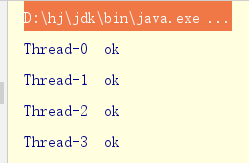

发现单例有问题,每次结果可能都不一样!
解决
// 懒汉式单例public class LazyMan { private LazyMan(){ System.out.println(Thread.currentThread().getName()+":: ok"); } private static LazyMan lazyMan; // 双重检测锁模式的 懒汉式单例 DCL懒汉式 public static LazyMan getInstance(){ if (lazyMan==null){ synchronized (LazyMan.class){ if (lazyMan==null){ lazyMan = new LazyMan(); } } } return lazyMan; } public static void main(String[] args) { for (int i = 0; i < 10 ; i++) { new Thread(()->{ LazyMan.getInstance(); }).start(); } }}
但在极端情况下还是可能出现问题

经历三个步骤:
1、 分配内存空间
2、 执行构造方法,初始化对象
3、 把这个对象指向这个空间
有可能会发生指令重排的操作!
比如,期望它执行 123 ,但是它真实可能执行132,比如第一个A线程过来执行了132,先分配空间再吧这个空间占用了,占用之后再去执行构造方法,如果现在突然来了个B线程,由于A已经指向这个空间了,它会以为这个 lazyMan 不等于 null ,直接return ,此时lazyMan还没有完成构造,所有必须避免这个问题!
必须加上volatile
// 懒汉式单例public class LazyMan { private LazyMan(){ System.out.println(Thread.currentThread().getName()+":: ok"); } // 避免指令重排 private volatile static LazyMan lazyMan; // 双重检测锁模式的 懒汉式单例 DCL懒汉式 public static LazyMan getInstance(){ if (lazyMan==null){ synchronized (LazyMan.class){ if (lazyMan==null){ lazyMan = new LazyMan(); } } } return lazyMan; } public static void main(String[] args) { for (int i = 0; i < 10 ; i++) { new Thread(()->{ LazyMan.getInstance(); }).start(); } }}静态内部类
// 静态内部类public class Holder { private Holder(){ } public static Holder getInstance(){ return InnerClass.HOLDER; } public static class InnerClass{ private static final Holder HOLDER = new Holder(); }}也是单例模式的一种,不安全!
单例不安全 反射
// 懒汉式单例public class LazyMan { private LazyMan(){ System.out.println(Thread.currentThread().getName()+":: ok"); } private volatile static LazyMan lazyMan; // 双重检测锁模式的 懒汉式单例 DCL懒汉式 public static LazyMan getInstance(){ if (lazyMan==null){ synchronized (LazyMan.class){ if (lazyMan==null){ lazyMan = new LazyMan(); //不是一个原子性操作 } } } return lazyMan; } //反射 public static void main(String[] args) throws Exception { LazyMan instance1 = LazyMan.getInstance(); Constructor<LazyMan> declaredConstructor = LazyMan.class.getDeclaredConstructor(null); declaredConstructor.setAccessible(true); // 无视了私有的构造器 // 通过反射创建对象 LazyMan instance2 = declaredConstructor.newInstance(); System.out.println(instance1); System.out.println(instance2); }}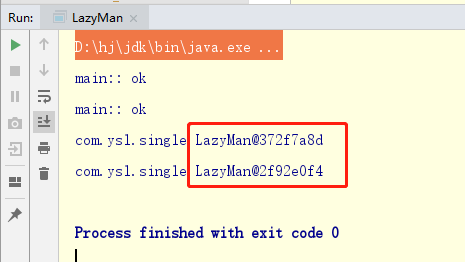
结论:反射可以破坏这种单例
解决
// 懒汉式单例public class LazyMan { private LazyMan(){ synchronized (LazyMan.class){ if (lazyMan!=null){ throw new RuntimeException("不要试图使用反射破环 异常"); } } System.out.println(Thread.currentThread().getName()+":: ok"); } private volatile static LazyMan lazyMan; // 双重检测锁模式的 懒汉式单例 DCL懒汉式 public static LazyMan getInstance(){ if (lazyMan==null){ synchronized (LazyMan.class){ if (lazyMan==null){ lazyMan = new LazyMan(); //不是一个原子性操作 } } } return lazyMan; } //反射 public static void main(String[] args) throws Exception { LazyMan instance1 = LazyMan.getInstance(); Constructor<LazyMan> declaredConstructor = LazyMan.class.getDeclaredConstructor(null); declaredConstructor.setAccessible(true); // 无视了私有的构造器 // 通过反射创建对象 LazyMan instance2 = declaredConstructor.newInstance(); System.out.println(instance1); System.out.println(instance2); }}
但是如果都用反射创建对象的情况下,还是会破环单例!
测试
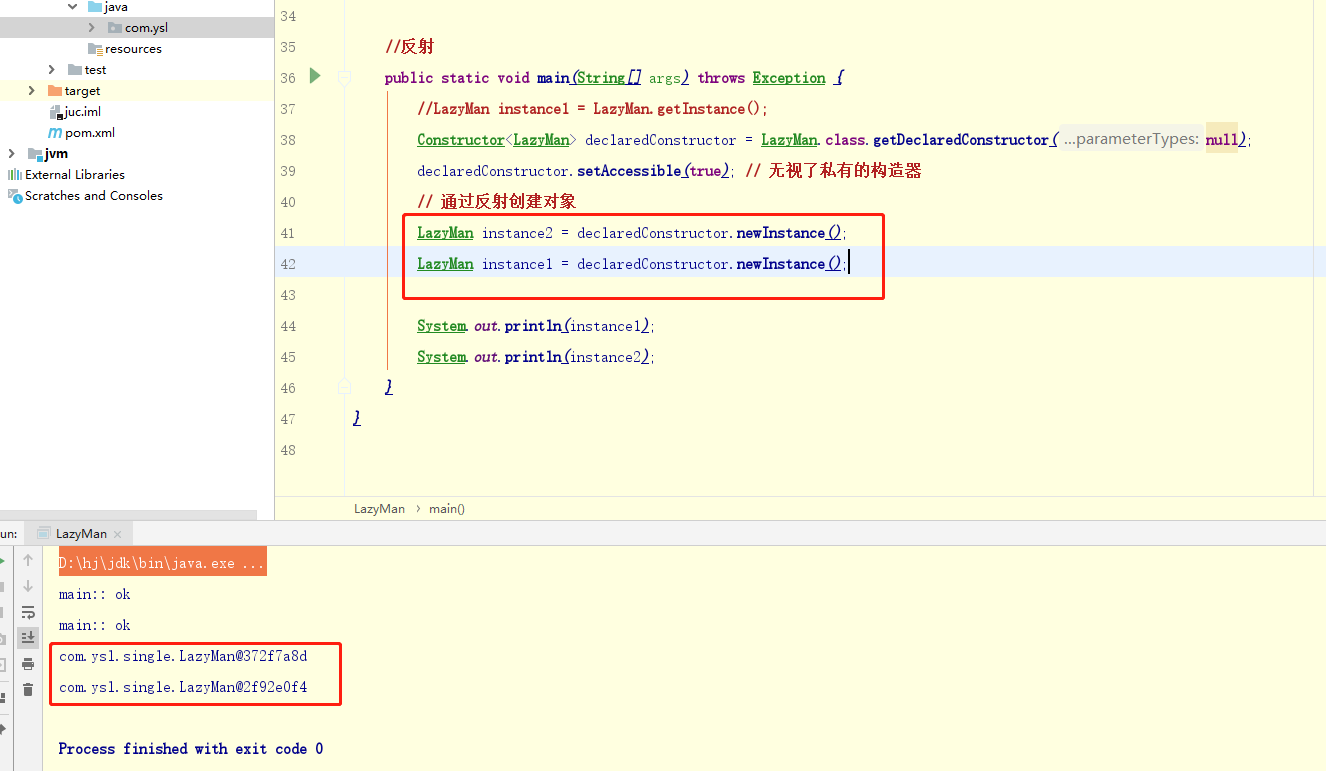
解决
// 懒汉式单例public class LazyMan { // 标志位 private static boolean abc = false; private LazyMan(){ synchronized (LazyMan.class){ if (abc==false){ abc=true; }else { throw new RuntimeException("不要试图使用反射破环 异常"); } } System.out.println(Thread.currentThread().getName()+":: ok"); } private volatile static LazyMan lazyMan; // 双重检测锁模式的 懒汉式单例 DCL懒汉式 public static LazyMan getInstance(){ if (lazyMan==null){ synchronized (LazyMan.class){ if (lazyMan==null){ lazyMan = new LazyMan(); //不是一个原子性操作 } } } return lazyMan; } //反射 public static void main(String[] args) throws Exception { //LazyMan instance1 = LazyMan.getInstance(); Constructor<LazyMan> declaredConstructor = LazyMan.class.getDeclaredConstructor(null); declaredConstructor.setAccessible(true); // 无视了私有的构造器 // 通过反射创建对象 LazyMan instance2 = declaredConstructor.newInstance(); LazyMan instance1 = declaredConstructor.newInstance(); System.out.println(instance1); System.out.println(instance2); }}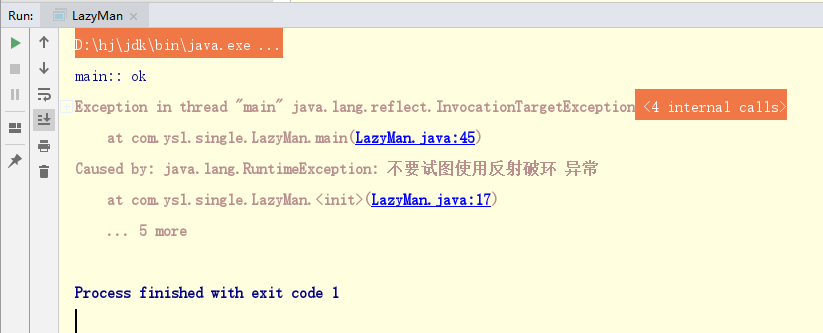
但是如果被人知道 abc这个变量,也可以破环!
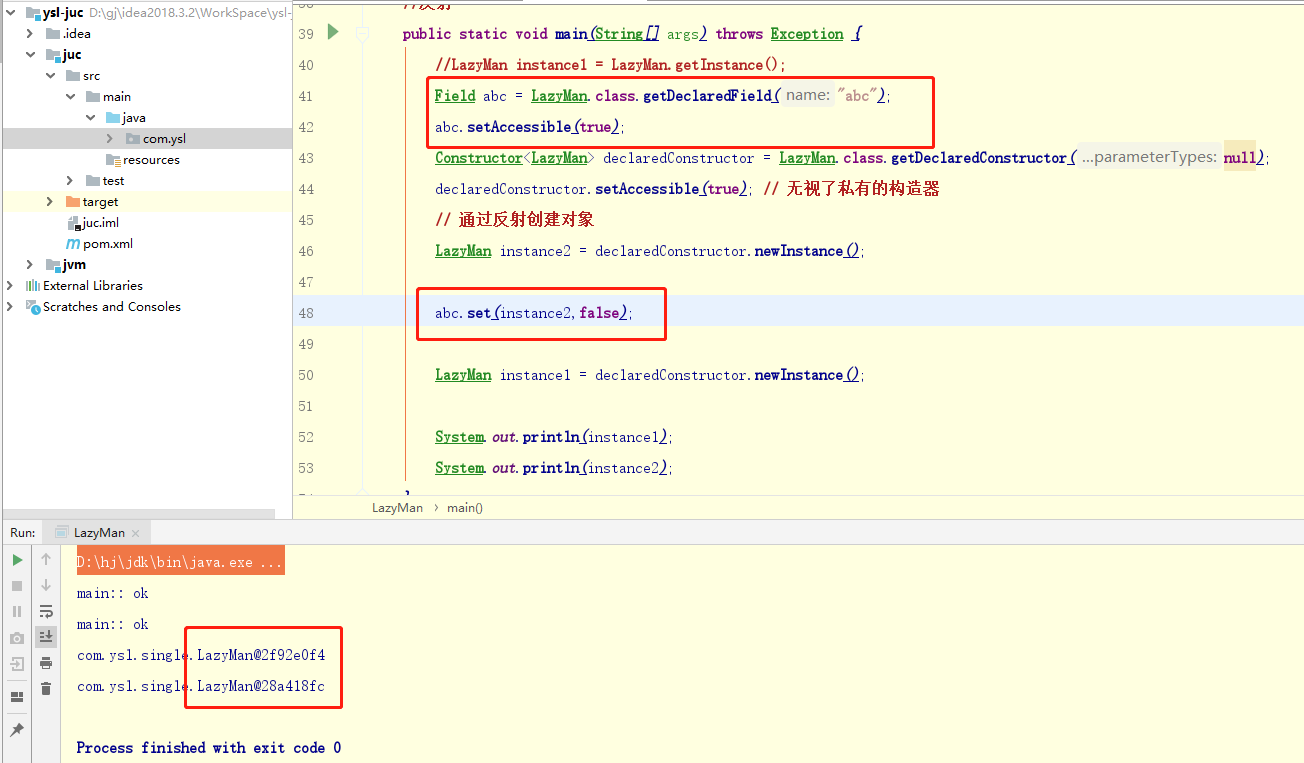
单例又被破环了!
看一下源码
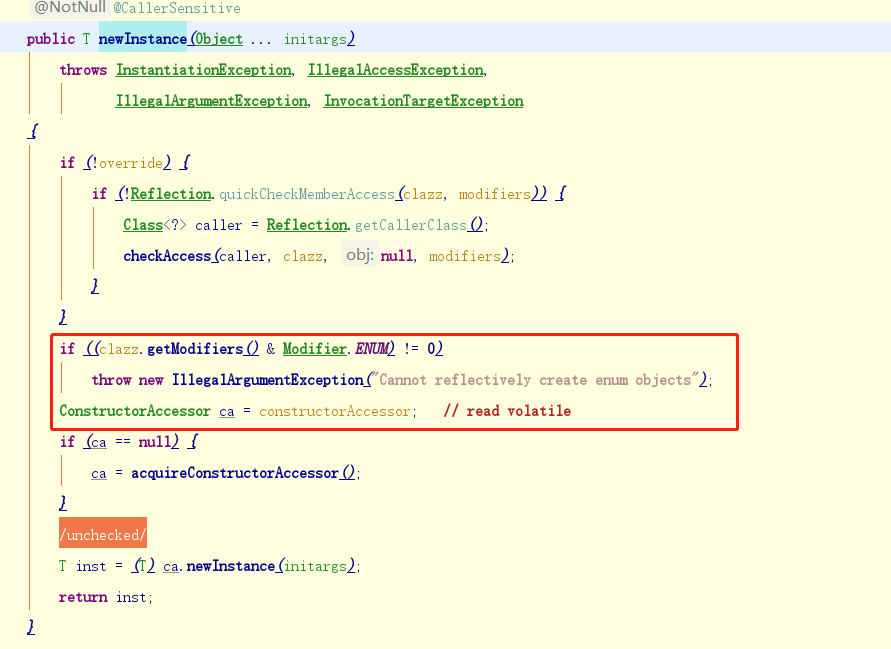
它说不能使用反射破环枚举,枚举是jdk1.5出现的,自带单例模式!
测试,写一个枚举类
// enum 本身就是一个class类public enum EnumSingle { INSTANCE; public EnumSingle getInstance(){ return INSTANCE; }}查看它的源码
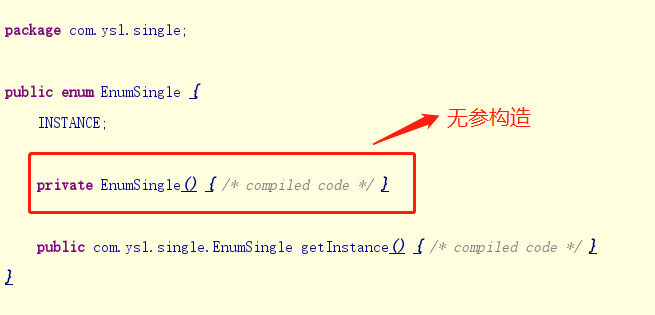
试图破环!
// enum 本身就是一个class类public enum EnumSingle { INSTANCE; public EnumSingle getInstance(){ return INSTANCE; }}class Test{ public static void main(String[] args) throws Exception { EnumSingle instance1 = EnumSingle.INSTANCE; Constructor<EnumSingle> declaredConstructor = EnumSingle.class.getDeclaredConstructor(null); declaredConstructor.setAccessible(true); EnumSingle instance2 = declaredConstructor.newInstance(); System.out.println(instance1); System.out.println(instance2); }}
它竟然说我现在的这个枚举类中没有空参构造器!
然后就去源码里分析!
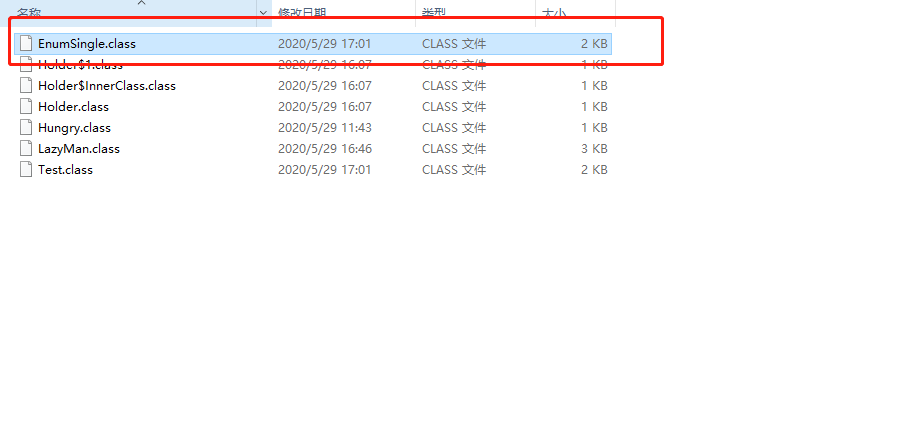
找到这个class文件!利用javap反编译一下!

发现这个也显示有一个空参构造,证明这个也不对,用第三方的工具查看!

利用它再吧class文件生成java文件!

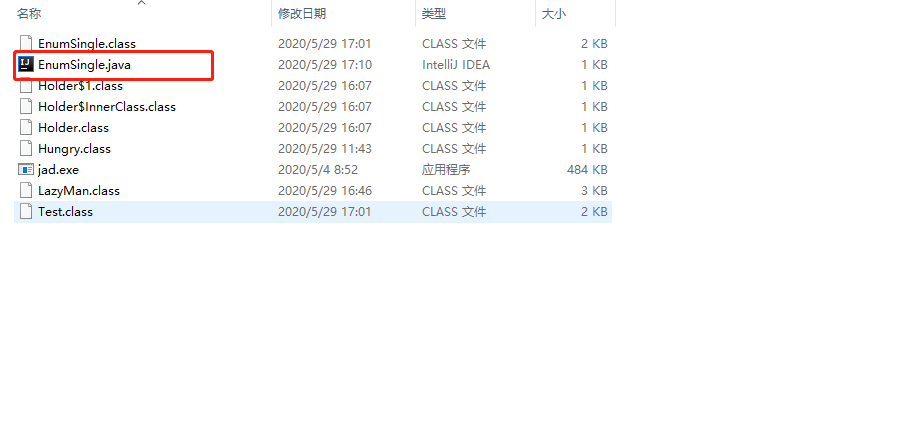
打开这个java文件
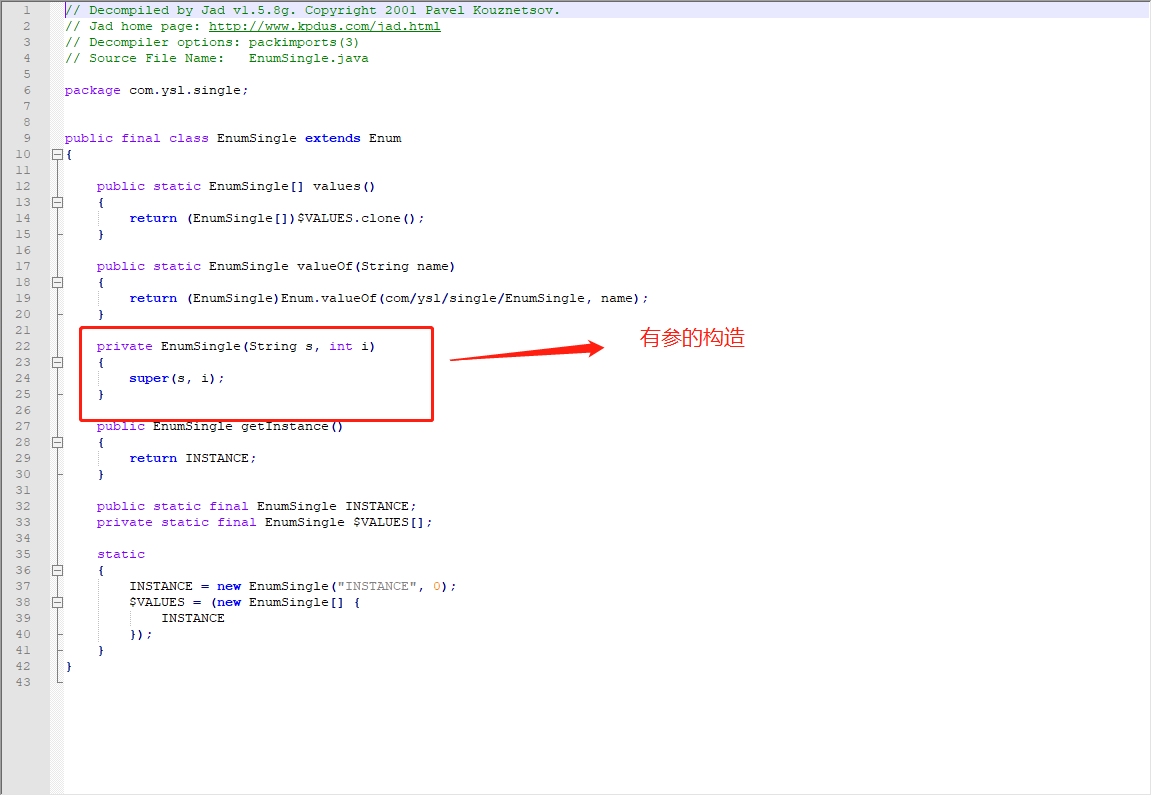
证明是idea和源码骗了我!
再次尝试破环!
// enum 本身就是一个class类public enum EnumSingle { INSTANCE; public EnumSingle getInstance(){ return INSTANCE; }}class Test{ public static void main(String[] args) throws Exception { EnumSingle instance1 = EnumSingle.INSTANCE; Constructor<EnumSingle> declaredConstructor = EnumSingle.class.getDeclaredConstructor(String.class,int.class); declaredConstructor.setAccessible(true); EnumSingle instance2 = declaredConstructor.newInstance(); System.out.println(instance1); System.out.println(instance2); }}
结论:反射无法破环枚举类!
No comments:
Post a Comment